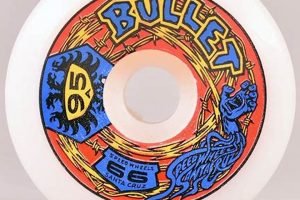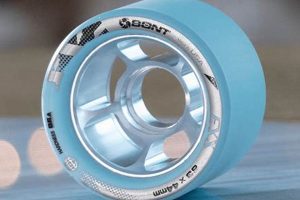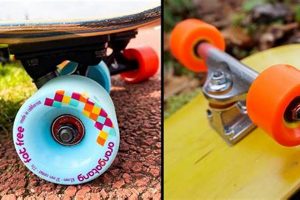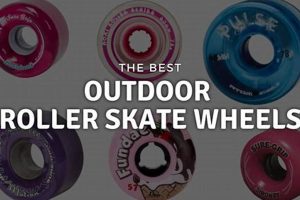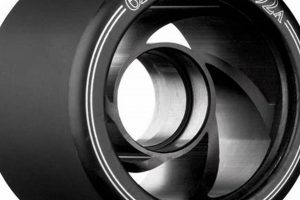Wheels of a specific diameter, measuring 53 millimeters, are a common choice for skateboarders. These components directly impact the board’s performance, influencing factors such as speed, acceleration, and the ability to navigate various terrains. For instance, a skateboarder might select wheels of this size for street skating, where a balance of speed and maneuverability is beneficial.
The popularity of this particular wheel size stems from its versatility. It provides a good compromise between larger wheels, which offer greater speed and roll-over ability, and smaller wheels, which provide quicker acceleration and lower center of gravity. This makes them suitable for a wide range of skating styles and skill levels. Historically, advancements in materials science have led to the development of more durable and higher-performing options in this size category, further solidifying its place in skateboarding culture.
The subsequent sections will delve into the specific characteristics that define these components, examining their durometer, shape, and core design. Furthermore, factors to consider when selecting suitable options for diverse skating disciplines will be explored. A detailed comparison of different brands and their respective offerings is also presented, giving a full understanding of the options available to skateboarders.
Selecting and Maintaining 53mm Skateboard Wheels
Proper selection and maintenance significantly impact performance and longevity. The following tips provide guidance for maximizing the potential of these components.
Tip 1: Durometer Selection: Consider the durometer, or hardness, rating. Softer options (78A-90A) provide superior grip on slick surfaces, suitable for cruising or filming. Harder options (97A-101A) offer increased speed and slide capabilities on smooth surfaces, common for street and park skating.
Tip 2: Wheel Shape Assessment: Evaluate the shape based on skating style. Rounded shapes enhance slide initiation and forgiveness, while square shapes offer increased grip and stability. Experiment to determine the ideal shape for individual preferences.
Tip 3: Bearing Maintenance: Regularly clean and lubricate bearings to ensure optimal rolling efficiency. Dirt and debris can significantly impede performance, reducing speed and increasing effort.
Tip 4: Rotation Practices: Rotate wheels periodically to promote even wear. Uneven wear can lead to instability and decreased performance. Regular rotation extends the lifespan and maintains a consistent feel.
Tip 5: Surface Compatibility: Choose options appropriate for the intended skating surface. Rough surfaces require more durable options, while smooth surfaces allow for a wider range of durometers and shapes.
Tip 6: Core Design Consideration: Examine the core design. A solid core provides increased stiffness and power transfer, while a hollow core reduces weight. The optimal choice depends on desired performance characteristics.
Tip 7: Regular Inspection: Routinely inspect for cracks, chips, or flat spots. Any damage can compromise performance and safety, necessitating replacement.
By adhering to these recommendations, skateboarders can optimize the performance and lifespan of their skateboard wheels, leading to an improved skating experience.
The final sections will elaborate on advanced techniques for wheel modification and customization, further enhancing the ability to tailor equipment to individual needs.
1. Diameter and Speed
Wheel diameter directly affects a skateboard’s speed. Larger diameters generally translate to higher top speeds due to greater ground coverage per rotation. However, a 53mm diameter represents a middle ground. While it does not offer the maximum potential speed achievable with larger diameters (e.g., 56mm or greater), it provides a balance that enhances acceleration and maneuverability. For example, a skateboarder using 53mm wheels may find it easier to quickly gain speed for performing flip tricks on flat ground, compared to using larger wheels that require more initial effort to accelerate.
The smaller diameter reduces the moment of inertia, making it easier to initiate rotation and change direction. This is particularly beneficial in technical street skating, where quick responses and agility are essential. In contrast, larger diameter wheels are often preferred for vert skating or downhill riding, where maintaining high speeds is paramount. The practical consequence of understanding this relationship is that skateboarders can choose wheel diameters that best suit their preferred style and terrain, optimizing their performance accordingly. A 53mm diameter represents a compromise between speed and agility, rendering it a versatile choice for various types of skating.
In summary, the diameter-speed relationship in skateboarding reveals that 53mm wheels offer a specific compromise, trading peak speed for enhanced acceleration and maneuverability. This understanding is critical for skateboarders seeking to optimize their equipment for particular skating styles and terrains. The challenge lies in balancing the need for speed with the need for control and responsiveness, a balance that 53mm wheels often effectively address. This core concept contributes to the larger theme of selecting appropriate skateboard components to maximize overall performance and rider satisfaction.
2. Durometer and Grip
Durometer, the measurement of a wheel’s hardness, directly correlates with its grip characteristics. This relationship is critical when selecting skateboard wheels, including those with a 53mm diameter, as it significantly impacts board control and riding experience.
- Softer Durometers (78A-90A): Enhanced Grip
Wheels with lower durometer ratings exhibit greater pliability, allowing them to conform to surface imperfections. This results in increased contact area, maximizing grip. For 53mm wheels, softer durometers are advantageous when navigating rough terrain or prioritizing stability over speed. For instance, a skateboarder using 53mm wheels with an 80A durometer may find it easier to maintain control on cracked pavement compared to harder wheels.
- Harder Durometers (97A-101A): Reduced Grip, Increased Slide
Higher durometer ratings indicate greater rigidity, reducing the wheel’s ability to grip. While this decreases traction, it facilitates smoother slides and enables faster speeds on smooth surfaces. Skateboarders using 53mm wheels with a 99A durometer will find it easier to perform controlled slides on polished concrete, a common technique in street skating. The trade-off is reduced grip on less-than-ideal surfaces.
- Surface Conditions: Influence on Durometer Choice
The prevailing surface conditions dictate the optimal durometer. Rough or uneven surfaces necessitate softer wheels to maximize grip and absorb vibrations. Smooth surfaces, such as skatepark ramps, permit the use of harder wheels, prioritizing speed and slide capabilities. A skateboarder using 53mm wheels needs to assess the typical skating environment to determine the most suitable durometer for the given conditions.
- Skating Style: Impact on Grip Requirements
Different skating styles place varying demands on grip. Technical street skating often benefits from slightly harder wheels that facilitate controlled slides and quick transitions. Cruising and downhill skating, conversely, often require softer wheels to ensure stability and maintain traction at higher speeds. A street skater may opt for a 53mm wheel with a 97A durometer, while a cruiser might prefer an 85A durometer in the same size.
The durometer-grip relationship directly influences the functionality of skateboard wheels. Understanding this dynamic allows skateboarders to select options that align with their specific needs and skating preferences. This knowledge is critical for optimizing performance and safety, ensuring a more enjoyable skateboarding experience, especially when choosing 53mm skateboard wheels.
3. Surface Compatibility
The selection of skateboard wheels, particularly those with a 53mm diameter, necessitates careful consideration of surface compatibility. The interaction between the wheel and the riding surface dictates performance characteristics such as speed, grip, and overall control. Rough or uneven surfaces demand wheels with specific properties to mitigate vibration and maintain contact, while smooth surfaces allow for a wider range of options. Failure to account for surface compatibility can result in reduced efficiency, increased risk of injury, and a diminished skating experience. For example, attempting to use a hard, narrow 53mm wheel designed for smooth skateparks on a cracked asphalt road will likely result in a jarring ride, loss of control, and potential damage to the wheel. Conversely, using an overly soft wheel on a smooth surface may result in excessive drag and reduced speed.
The durometer of the wheel is a primary factor in surface compatibility. Softer wheels, typically with a durometer rating below 90A, are better suited for rougher surfaces. Their increased flexibility allows them to conform to imperfections, providing better grip and absorbing vibrations. Conversely, harder wheels, often rated above 97A, are more efficient on smooth surfaces where grip is less of a concern. The shape of the wheel’s edge also plays a role. Rounded edges tend to roll over cracks and debris more easily than sharp edges, making them a better choice for street skating on varied terrain. In contrast, square-edged wheels provide more grip on smooth, consistent surfaces like skatepark ramps. The material composition also contributes to surface compatibility, with certain urethanes offering superior abrasion resistance or enhanced grip characteristics. Therefore, selecting a 53mm wheel that is appropriately designed for the intended riding surface is essential for optimizing performance and ensuring rider safety.
In summary, surface compatibility is a crucial consideration when choosing skateboard wheels. The ideal wheel characteristics, including durometer, shape, and material, are dictated by the intended riding environment. Ignoring this relationship can lead to a compromised skating experience, increased risk of injury, and premature wear of the equipment. Understanding the interplay between surface and wheel properties enables skateboarders to make informed decisions that maximize performance and enjoyment. This understanding further allows for safer skating experiences on a variety of terrains.
4. Core Material Influence
The core material within a 53mm skateboard wheel significantly impacts its overall performance characteristics. The core, typically constructed from a rigid plastic or composite material, provides structural integrity and influences the wheel’s response to applied forces. The selection of core material affects energy transfer, bearing alignment, and resistance to deformation under stress. A stiffer core, for instance, promotes more efficient energy transfer from the rider’s push to the pavement, resulting in increased speed and responsiveness. Conversely, a less rigid core may offer improved vibration dampening, but at the cost of energy efficiency. For example, a 53mm wheel with a high-rebound polyurethane outer layer and a stiff nylon core will generally provide a faster and more responsive ride compared to a similar wheel with a softer core material. The specific material properties, such as hardness, density, and modulus of elasticity, contribute directly to the wheel’s performance profile.
Furthermore, the core material directly affects bearing alignment and lifespan. A properly designed and manufactured core ensures that the bearings are held securely and precisely aligned, minimizing friction and maximizing bearing lifespan. Misalignment can lead to premature bearing wear, reduced speed, and increased vibration. Different core designs, such as those incorporating conical or ribbed structures, are employed to enhance bearing support and distribute load more evenly. Additionally, the core’s resistance to heat buildup is a critical factor, particularly in high-performance applications. Excessive heat can soften the urethane layer and degrade bearing lubricant, leading to performance degradation and potential wheel failure. A core material with good thermal conductivity can help dissipate heat, maintaining optimal wheel performance under demanding conditions. Certain high-end 53mm wheels utilize advanced composite core materials designed to offer superior stiffness, heat resistance, and bearing support.
In conclusion, the core material is a critical component of a 53mm skateboard wheel, influencing its speed, responsiveness, bearing alignment, and overall durability. The selection of an appropriate core material requires careful consideration of the intended application and desired performance characteristics. A stiff core generally enhances energy transfer and responsiveness, while a well-designed core ensures proper bearing alignment and heat dissipation. Understanding the influence of core material allows skateboarders to make informed decisions and select wheels that optimize their riding experience. The core material becomes an important factor for users to improve their skating performance with the right tools.
5. Skating Style Suitability
The appropriateness of a 53mm wheel is intrinsically linked to the intended skating style. Wheel size significantly affects performance attributes such as acceleration, top speed, and maneuverability. Consequently, selecting a wheel diameter that aligns with the demands of a specific skating discipline is paramount. Mismatched equipment diminishes efficiency and potentially compromises safety.
For example, technical street skating, characterized by frequent starts and stops, intricate maneuvers, and grinds on various obstacles, often benefits from a 53mm wheel. The smaller diameter facilitates quicker acceleration and a lower center of gravity, enhancing stability and responsiveness during trick execution. Conversely, disciplines such as vert skating or long-distance cruising, where sustained high speeds are crucial, typically favor larger diameter wheels. The 53mm wheel, in these contexts, may prove less efficient due to its limited top-end velocity. Furthermore, the durometer, or hardness, of the wheel must also correspond to the skating style. Harder wheels are generally preferred for street skating due to their reduced friction and increased slide capability, while softer wheels offer enhanced grip and vibration absorption, making them suitable for cruising on rougher surfaces. The core material contributes to the wheels response and power transfer, a factor also to be considered in stylistic alignment. Therefore, a careful evaluation of the wheel’s characteristics in relation to the demands of the intended skating style is essential for optimizing performance and enjoyment.
Ultimately, the effectiveness of a 53mm skateboard wheel is contingent upon its suitability for the chosen skating discipline. While it offers a versatile compromise for many skaters, its performance advantages are maximized when paired with a style that leverages its strengths, such as technical street skating. Challenges arise when attempting to apply this wheel size to disciplines that demand significantly different performance characteristics. A comprehensive understanding of this relationship allows skateboarders to make informed decisions that optimize their equipment and enhance their overall skating experience. The specific selection should be driven by the user’s needs.
Frequently Asked Questions
This section addresses common inquiries regarding the selection, application, and maintenance of skateboard wheels measuring 53 millimeters in diameter. The information provided aims to clarify misconceptions and offer practical guidance for informed decision-making.
Question 1: What skating styles are best suited for 53mm skateboard wheels?
Wheels of this diameter are generally considered versatile and suitable for street skating, park skating, and general cruising. The size offers a balance between acceleration and top speed, making it appropriate for a variety of terrains and skill levels. However, specialized disciplines such as downhill or long-distance skating may benefit from larger wheel diameters.
Question 2: How does durometer impact the performance of 53mm skateboard wheels?
Durometer, a measure of wheel hardness, significantly affects grip and slide characteristics. Softer wheels (lower durometer ratings) provide greater grip on rough surfaces, while harder wheels (higher durometer ratings) offer increased speed and slide capabilities on smooth surfaces. The selection should align with the intended skating environment.
Question 3: Can 53mm skateboard wheels be used for vert skating?
While possible, larger diameter wheels are typically preferred for vert skating. Vert ramps require sustained high speeds, which are more efficiently achieved with larger wheels that maintain momentum better. A 53mm wheel may necessitate more frequent pushing to maintain speed on a vert ramp.
Question 4: What bearing size is compatible with 53mm skateboard wheels?
Virtually all skateboard wheels, including 53mm options, utilize the standard 608 bearing size. This standardization ensures compatibility across different wheel brands and skateboard trucks.
Question 5: How frequently should 53mm skateboard wheels be replaced?
Replacement frequency depends on usage intensity, skating surface, and wheel quality. Signs of wear, such as flat spots, chipping, or significant diameter reduction, indicate the need for replacement. Regular inspection and rotation can extend the lifespan.
Question 6: Does the core design of 53mm skateboard wheels affect performance?
Yes, the core design influences stiffness and energy transfer. A stiffer core provides increased responsiveness and power transfer, while a softer core may offer better vibration absorption. The optimal core design depends on individual preferences and skating style.
In summary, 53mm skateboard wheels present a balanced option suitable for a range of skating styles. The selection process requires careful consideration of durometer, surface compatibility, and core design to optimize performance and ensure rider satisfaction.
The subsequent section will provide guidance on troubleshooting common issues encountered with skateboard wheels, addressing concerns such as bearing maintenance and wheel wear.
Conclusion
This exploration has established that 53mm skate wheels occupy a critical middle ground in skateboarding equipment, offering a balance between speed, acceleration, and maneuverability suitable for various skating styles, particularly street and park disciplines. The informed selection of these components requires a nuanced understanding of durometer, surface compatibility, and core material influence. Disregard for these factors can lead to compromised performance and safety.
The continued refinement of materials and manufacturing processes will undoubtedly yield advancements in 53mm skate wheel technology, further optimizing their performance characteristics and expanding their applicability. Skateboarders are encouraged to diligently research and critically assess available options to ensure their equipment aligns with their specific needs and skating environment, thereby maximizing their potential and enhancing the overall skateboarding experience.


